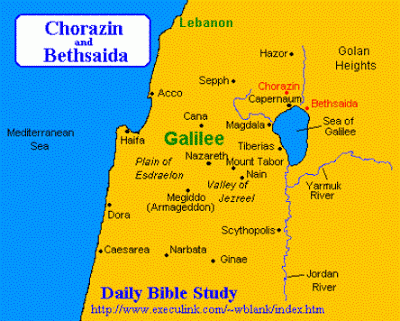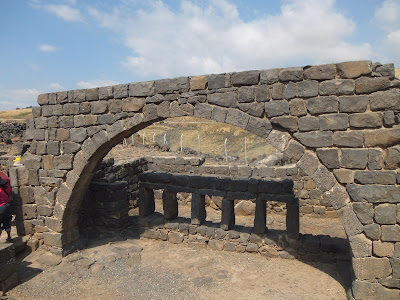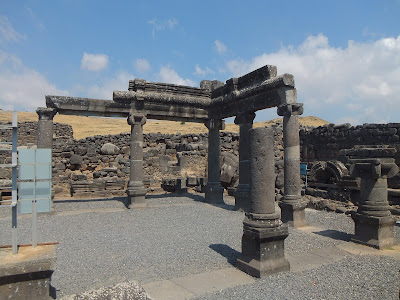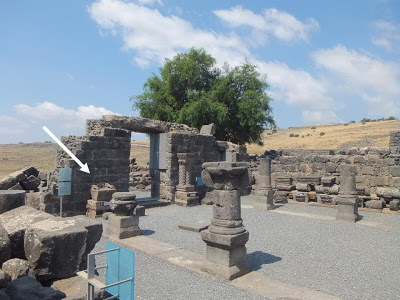Chorazin is about two and a half miles from Capernaum on the northern shore
of the Sea of Galilee.
 |
| source: Daily
Bible Study |
Chorazin, along with Bethsaida and Capernaum, was named in the New
Testament gospels of Matthew and Luke as cities that Jesus cursed because
they rejected him and did not repent.(Matthew 11:20-24; see also Luke
10:13-15)
MT 11:20 Then Jesus began to denounce the cities in which most of his
miracles had been performed, because they did not repent. 21 "Woe to you,
Korazin! Woe to you, Bethsaida! If the miracles that were performed in you
had been performed in Tyre and Sidon, they would have repented long ago in
sackcloth and ashes. 22 But I tell you, it will be more bearable for Tyre
and Sidon on the day of judgment than for you. 23 And you, Capernaum, will
you be lifted up to the skies? No, you will go down to the depths. If the
miracles that were performed in you had been performed in Sodom, it would
have remained to this day. 24 But I tell you that it will be more bearable
for Sodom on the day of judgment than for you."
The three places, Capernaum, Chorazin and Bethsaida are known as “the
evangelical triangle” by some scholars today. Jesus performed in the
evangelical triangle his “mighty works” and laid the foundation of his
ministry.In Capernaum, he healed a paralyzed man. In order to get him to the
house, the audience had to remove the roof of the building and lower him
through it.
In another episode a Roman military commander (a centurion), who dwelt in
the village, approached him. The centurion asked him to heal a boy who was
lying sick at his home. The centurion knew that Jesus would not go to his
home to heal the child because a Halakhah (Jewish law), decreed by the
Rabbis, forbade Jews to enter gentiles’ homes. Jesus was thrilled by the
centurion’s faith because he did not find such faith among his Jewish
fellowmen.
“Go home,” he said, “and the boy will be healed.”
In the evangelical triangle Jesus met his first disciples. They were
Simon-Peter, the fisherman from Bethsaida, and his brother Andrew. Jesus
told them to stop being fishers of fish and become fishers of men. Philip,
another disciple, was from Bethsaida as well. Two more fishermen, James and
John, the sons of Zebedee, probably also came from this town. In addition to
healing individuals, Jesus performed miracles to the multitude. On a plain
not far from Bethsaida, he was followed by a crowd of 5,000 people and when
there was nothing for the crowd to eat, Jesus managed to feed the crowd with
just two fish and five loaves of bread (Matt. 14:13-21).
On two other occasions he preached the famous sermons in which he laid the
foundation of the Christian faith. One sermon was made from the top of a
mound and the other was made from a boat to a crowd who had gathered on the
seashore.(source: Dr. Rami Arav, Professor at the University of Nebraska,
Omaha and the Director of the Bethsaida Excavations Project)

The city was established in the 1st century AD. The remains that are
seen today belong to a later period, the period of the Mishna and Talmud
(3rd/4th century AD), when the city was expanded.
The Jewish Synagogue was built in the Byzantine period, in the 3rd/4th
century, according to a hoard of coins found under the synagogue. The
synagogue is a typical rectangular 23M long, 17M wide, double row
structure, north-south orientation. Its style is similar to the
Capernaum and Hammat-Gader synagogues.
The site was destroyed at the middle of the 4th C, as described by
Eusebius of Caesarea, which relates the destruction of the city to the
prophecy of Jesus. This was also established by the excavations. The
destruction may have been caused by an earthquake (363 AD).
The site was restored at the end of the 4th C, and continued until the
8th C. It expanded during the early Arabic period (7-8th C AD). After a
gap of several hundred years, was revived in the 13th C. Near the
entrance there is a tomb from the Mamluk period - the grave of Sheik
Ramadan. (source: http://www.biblewalks.com/Sites/Korazim.html)
 |
| ruins leading to
the synagogue |
 |
| stone ruins of the
central residential area |
 |
| a Galilee style
synagogue |
The synagogue at Chorazin is a typical "Galilean" style synagogue. These
synagogues are characterized by 1) a basilical shape with three hallways
separated by two rows of pillars; 2) three doorways and the central one is
the largest; 3) benches around the interior walls; 4) a stylobate to support
the weight of the arches.(source: http://www.bibleplaces.com/chorazin.htm)
 |
| archway in the
walls of the synagogue which leads to the ritual bath |
 |
| pillars supporting
the roof of the syngagogue |
 |
| The Seat of Moses
in the synagogue |
2 "The teachers of the law and the Pharisees sit in Moses' seat. 3
So you must obey them and do everything they tell you. But do not do what
they do, for they do not practice what they preach. 4 They tie up heavy
loads and put them on men's shoulders, but they themselves are not willing
to lift a finger to move them. (Matt 23:2-3)
With great revelation comes great accountability
Many of us are familiar with the quote “with great power comes great
responsibility.” We attribute it to Stan Lee in Amazing Fantasy #15,
August 1962 (the first Spider-Man story) and from "Uncle" Ben
Parker, in the Spider-Man (2002) movie. Actually the quote
originated from Voltaire in France in 1832. This quote tells of the
moral obligation of great power.
In Matthew 11:20-24 and Luke 10:13-15 where Jesus
denounced/upbraided/cursed Chorazin, along with Bethsaida and
Capernaum because the people rejected him in spite of the fact that
in these cities Jesus spent a lot of time teaching and performed
most of his miracles. The moral implication of receiving more
revelations of God is to repent. Coming closer to the Holy God will
bring to light our own sinfulness and should lead to repentance. Yet
the people of Chorazin, Bethsaida and Capernaum did not repent.
Before we make excuses for them that a prophet is not recognized in
his hometown, these are not Jesus’ hometowns. Jesus is from
Nazareth.
Many of us, as Christians, think that as long as we are saved by the
redemptive work of Christ on the cross, we are okay. We have the
ticket to eternal life. Why do we need to please God anymore? Why do
we need to go out of our way to live a life of holiness? Is it not
enough to turn up in church now and then, tithe a little and
continue living the life we enjoy? It is hard to be countercultural
as kingdom living is. Much easier, comfortable and be part of the
in-crowd to be living as the non-believers do. In some ways, we are
similar to the ancient Jews in Chorazin, Bethsaida and Capernaum.
They are God’s chosen people as evidenced by the Temple in Jerusalem
and they have the Torah. What else is needed?
For the basis of what else is needed I will like to coin a phrase
“with great revelation comes great accountability.” Yes, we have
averted the eternal wraith of God but we have a moral impetus to
become holy or like Christ himself. There are two judgments by God
in the Bible. One is for non-Christians and the other is for
Christians. Everyone has to be accountable for their own actions.
For non-Christian, the Great White Throne judgment is found in
Revelations 20:11-15. For Christians, the judgment at the Day of the
Judgment Seat of Christ is not for the sins (which Jesus have
redeemed) but for our actions (1 Cor. 3:11-15).
11 For no
one can lay any foundation other than the one already laid, which is
Jesus Christ. 12 If
any man builds on this foundation using gold, silver, costly stones,
wood, hay or straw, 13 his
work will be shown for what it is, because the Day will bring it to
light. It will be revealed with fire, and the fire will test the
quality of each man's work.
14 If what he
has built survives, he will receive his reward.
15 If it is
burned up, he will suffer loss; he himself will be saved, but only
as one escaping through the flames.
God has not ceased to reveal himself to us. As revelation in Jesus’
time should lead to repentance, revelation in our time will cause us
to become more like Christ. In other words, revelation will help to
strengthen our faith and make us holy (sanctification). The impetus
is for us to live holy lives so that Jesus will not
denounced/upbraided/cursed our actions on earth on that fateful Day.
May he instead say, “well done, good and faithful servant.”
| 5 December 2012 |










